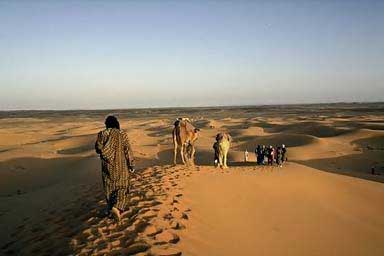Plants & Animals Of The Sahara Desert
|
The Sahara Desert is the world’s largest hot desert and is spread across 8.6 million square kilometers in Northern Africa. However, only about 200,000 square kilometers of Sahara is fertile, owing to the fact that the land in these areas is constantly fed by underground rivers, reservoirs or artisan wells.
|
The soil is low in humus and is saline in low lying areas. As a result, plant growth is sparse. The problem is compounded by the severely dry weather which causes desiccation of plants due to high rate of transpiration and evaporation of water from the leaves.
To be able to survive in these extremely harsh and inhospitable conditions, plants and animals need to have certain adaptations like modification of broad leaves into spines to prevent excessive loss of water from the plant body (in desert plants like cactus) and desert animals spending most of the day underground and out of the hot sun. Desert animals meet their water needs by eating such foods which contain a lot of water content like the succulent stems of cactus, and certain seeds which are high in water content. They very rarely meet their water requirement by drinking water. They rarely come out or get exposed in the hot sun and prefer to stay underground during most part of the day. Animals like rattlesnakes, kangaroo rats, and kit foxes come out in the open only during night for hunting. Most desert animals are small in size and this reduced size minimizes loss of water from the animal’s body.
In the Sahara, the vegetation primarily consists of xerophytes and halophytes (plants which thrive in habitats rich in salts such as semi-deserts, salt marshes and sea coasts), grasses, shrubs, and trees. Desert plants like the African Welwitchsia possess very long roots that penetrate very deep into the earth and help the plant survive in the hot and dry desert conditions. Similarly, plants like the African Peyote Cactus have thick stems which help them to hold water for a very long time, and their leaves are reduced to spines which help them to minimize water loss through the leaf stomata. The common desert plants include cypress, olive, acacia and artemisia, doum palm, oleander, date palm, and thyme, while the common types of grasses include Eragrostis, Panicum, and Aristida. Vegetation growth is more concentrated in oases and along river beds.
The animal population in the Sahara consists of animals like gerbil, jerboa, cape hare, the desert hedgehog, dorcas gazelle, barbary sheep, oryx, dama deer, Nubian wild, anubis baboon, spotted hyena, common jackal, sand fox, Libyan striped weasel, the slender mongoose, frogs, toads, crocodiles, lizards, chameleons, skinks, cobras snails, brine and algae shrimps. The avian species in the Sahara desert include birds like ostriches, raptors, secretary birds, guinea fowl, Nubian bustards, desert eagle and barn owls, sand larks, pale crag martins, and brown-necked and fan-tailed ravens.
More Articles :

|
